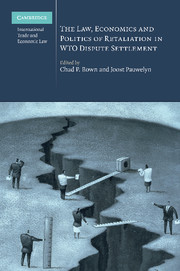Book contents
- Frontmatter
- Contents
- List of tables and figures
- Contributors
- Introduction: trade retaliation in WTO dispute settlement: a multi-disciplinary analysis
- PART I Background and goal(s) of WTO retaliation
- PART II A legal assessment after ten arbitration disputes
- PART III An economic assessment after ten arbitration disputes
- PART IV The domestic politics and procedures for implementing trade retaliation
- 8 The United States' experience and practice in suspending WTO obligations
- 9 The European Community's experience and practice in suspending WTO obligations
- 10 The politics of selecting trade retaliation in the European Community: a view from the floor
- 11 Canada's experience and practice in suspending WTO obligations
- 12 Is retaliation useful? Observations and analysis of Mexico's experience
- 13 Procedures for the design and implementation of trade retaliation in Brazil
- 14 Retaliation in the WTO: the experience of Antigua and Barbuda in US–Gambling
- PART V Problems and options for reform
- PART VI New frontiers and lessons from other fields
- Index
11 - Canada's experience and practice in suspending WTO obligations
Published online by Cambridge University Press: 26 February 2010
- Frontmatter
- Contents
- List of tables and figures
- Contributors
- Introduction: trade retaliation in WTO dispute settlement: a multi-disciplinary analysis
- PART I Background and goal(s) of WTO retaliation
- PART II A legal assessment after ten arbitration disputes
- PART III An economic assessment after ten arbitration disputes
- PART IV The domestic politics and procedures for implementing trade retaliation
- 8 The United States' experience and practice in suspending WTO obligations
- 9 The European Community's experience and practice in suspending WTO obligations
- 10 The politics of selecting trade retaliation in the European Community: a view from the floor
- 11 Canada's experience and practice in suspending WTO obligations
- 12 Is retaliation useful? Observations and analysis of Mexico's experience
- 13 Procedures for the design and implementation of trade retaliation in Brazil
- 14 Retaliation in the WTO: the experience of Antigua and Barbuda in US–Gambling
- PART V Problems and options for reform
- PART VI New frontiers and lessons from other fields
- Index
Summary
Since the establishment of the WTO in 1995 Canada has been involved in at least thirty disputes as a complainant. Of these thirty complaints, only seven have resulted in Canada seeking authorization from the Dispute Settlement Body (DSB) of the WTO to suspend tariff concessions or other obligations against another WTO member: EC–Hormones; Australia–Salmon; Brazil–Aircraft; <I>US–CDSOA; US–Softwood Lumber III; US–Softwood Lumber V; and US–Softwood Lumber IV. Of these seven cases, only three cases reached the stage where Canada received the authorization to suspend tariffs or other obligations, and in only two of those cases did it actually impose the retaliation rights it received (EC–Hormones and US–CDSOA).
Like many other WTO members, when a request for authorization to retaliate is being considered, Canada prepares its list for retaliation after a series of consultations has been completed. As a first step, the Government of Canada will conduct its own research into the products imported from the target member. Once Canada has compiled this list according to HS codes, it will select a list of possible goods to target based on its analysis of the value of trade that could fit within the requested level of retaliation. The second step is to publish and notify to the likely industries that Canada may be seeking to raise the bound rates of certain targeted goods.
- Type
- Chapter
- Information
- Publisher: Cambridge University PressPrint publication year: 2010

